ITEC871 - Information Systems Design and Management: Project Report
VerifiedAdded on 2022/10/01
|10
|1250
|139
Report
AI Summary
This report, prepared for ITEC871, focuses on the prioritization of IT projects for a large manufacturing company. The assignment involves the application of two distinct models: the strategic model, which prioritizes projects based on their alignment with the company's strategic objectives (quality, attracting employees, cost reduction, and IT infrastructure), and the high-potential model, which assesses projects based on their potential for future success and market trends. The report provides a detailed comparison of these models, highlighting their differing approaches to project ranking and resulting in two distinct prioritized lists. The key recommendations stemming from the analysis suggest that strategic projects should be given high priority during implementation, while high-potential projects should undergo pilot programs to gather more market data. The report concludes by emphasizing the value of these models in structuring project rankings to support informed decision-making by the executive board.
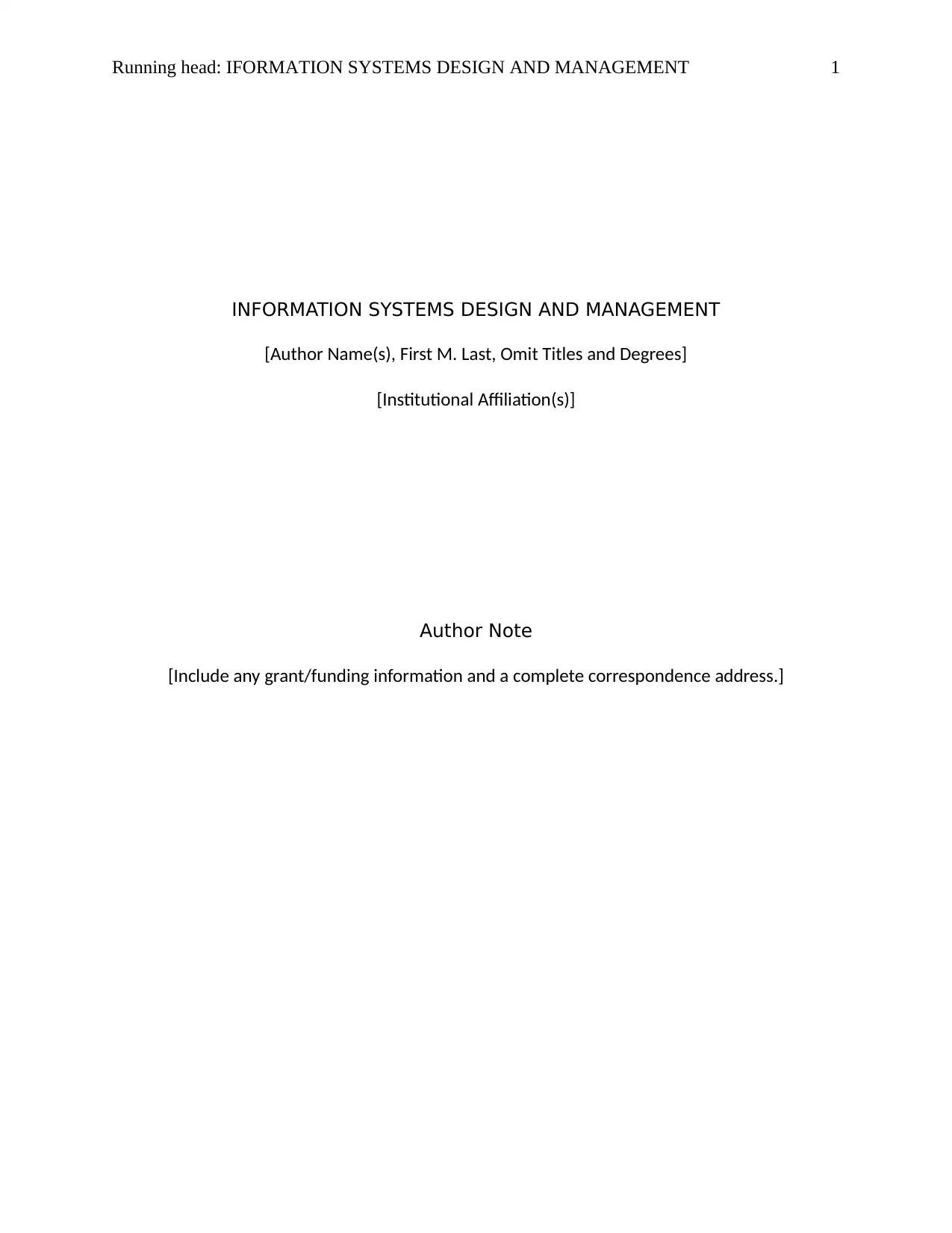
Running head: IFORMATION SYSTEMS DESIGN AND MANAGEMENT 1
INFORMATION SYSTEMS DESIGN AND MANAGEMENT
[Author Name(s), First M. Last, Omit Titles and Degrees]
[Institutional Affiliation(s)]
Author Note
[Include any grant/funding information and a complete correspondence address.]
INFORMATION SYSTEMS DESIGN AND MANAGEMENT
[Author Name(s), First M. Last, Omit Titles and Degrees]
[Institutional Affiliation(s)]
Author Note
[Include any grant/funding information and a complete correspondence address.]
Paraphrase This Document
Need a fresh take? Get an instant paraphrase of this document with our AI Paraphraser
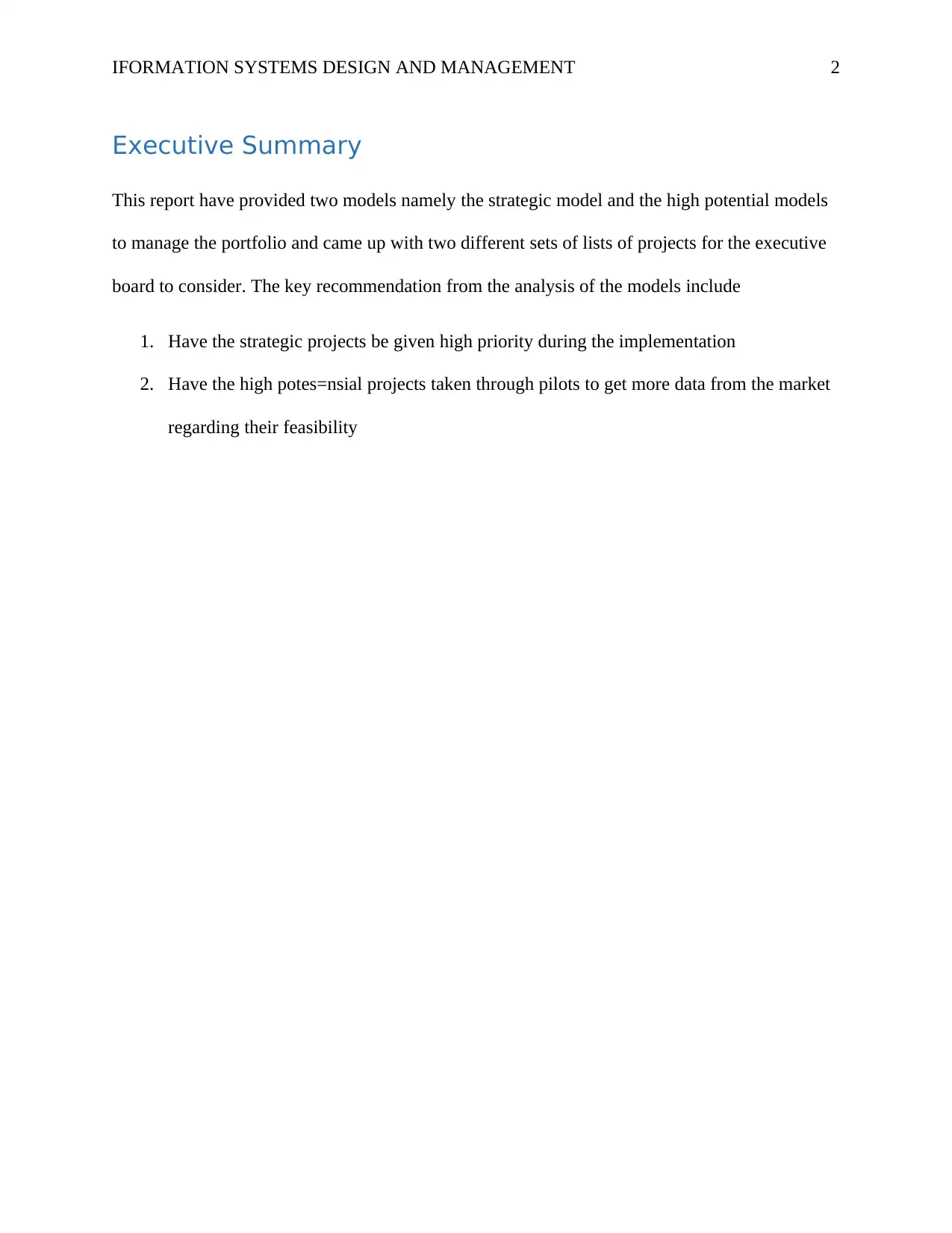
IFORMATION SYSTEMS DESIGN AND MANAGEMENT 2
Executive Summary
This report have provided two models namely the strategic model and the high potential models
to manage the portfolio and came up with two different sets of lists of projects for the executive
board to consider. The key recommendation from the analysis of the models include
1. Have the strategic projects be given high priority during the implementation
2. Have the high potes=nsial projects taken through pilots to get more data from the market
regarding their feasibility
Executive Summary
This report have provided two models namely the strategic model and the high potential models
to manage the portfolio and came up with two different sets of lists of projects for the executive
board to consider. The key recommendation from the analysis of the models include
1. Have the strategic projects be given high priority during the implementation
2. Have the high potes=nsial projects taken through pilots to get more data from the market
regarding their feasibility

IFORMATION SYSTEMS DESIGN AND MANAGEMENT 3
Table of Contents
Executive Summary.........................................................................................................................1
Introduction......................................................................................................................................3
Models.............................................................................................................................................4
Strategic models...........................................................................................................................4
High Potential Model...................................................................................................................5
Comparison of Models................................................................................................................6
Conclusion.......................................................................................................................................7
Recommendations............................................................................................................................8
References........................................................................................................................................9
Table of Contents
Executive Summary.........................................................................................................................1
Introduction......................................................................................................................................3
Models.............................................................................................................................................4
Strategic models...........................................................................................................................4
High Potential Model...................................................................................................................5
Comparison of Models................................................................................................................6
Conclusion.......................................................................................................................................7
Recommendations............................................................................................................................8
References........................................................................................................................................9
⊘ This is a preview!⊘
Do you want full access?
Subscribe today to unlock all pages.

Trusted by 1+ million students worldwide

IFORMATION SYSTEMS DESIGN AND MANAGEMENT 4
Introduction
Business all over the world normally has one or two projects in its portfolio management. These
projects are always not listed in any order of priority. The resources to satisfy all these projects is
unlimited therefore, the business must always make a choice on which projects to be given
priority and pursued as opposed to others. Arriving at a prioritized list of projects to undertake is
a tedious task for project manager as they have to find a balance between the cost and benefits of
pursuing individual projects, the risk involved and the strategic company objectives (Sironi,
2015).
To achieve this goal, several portfolio ranking models have been discussed and elaborate so that
project managers can have a more structured approach in coming up with the portfolio project
rankings. This report details the approaches and models undertaken to rank the listed projects in
order of priority for the executive management to review and action (Schrage, 2018).
Introduction
Business all over the world normally has one or two projects in its portfolio management. These
projects are always not listed in any order of priority. The resources to satisfy all these projects is
unlimited therefore, the business must always make a choice on which projects to be given
priority and pursued as opposed to others. Arriving at a prioritized list of projects to undertake is
a tedious task for project manager as they have to find a balance between the cost and benefits of
pursuing individual projects, the risk involved and the strategic company objectives (Sironi,
2015).
To achieve this goal, several portfolio ranking models have been discussed and elaborate so that
project managers can have a more structured approach in coming up with the portfolio project
rankings. This report details the approaches and models undertaken to rank the listed projects in
order of priority for the executive management to review and action (Schrage, 2018).
Paraphrase This Document
Need a fresh take? Get an instant paraphrase of this document with our AI Paraphraser

IFORMATION SYSTEMS DESIGN AND MANAGEMENT 5
Models
The following models were used to rank the projects
IT Portfolio Model
Product Matrix Model
Each of the above models is discussed below
Strategic models
This model focuses on projects that have the potential to meet strategic business needs. They are
those critical projects that are important in achieving corporate strategy. Projects that bring some
desirable competitive advantage falls under this category (Alford, Luchtenberg, & Reddie,
2018). The cost reduction projects again are listed in this category as the company has set up
procedures to ensure the cost of doing business is brought down as much as possible. Thirdly,
those projects that improve the level of customer satisfaction is highly recommended for this
category as the company has endeavored to ensure they attract and retain good people (Zhou,
Mei, & Chen, 2019).
The following are the key business strategies that the company wants to model projects around
Quality products
Attracting and holing people
Reduce cost
Maintain secure and adaptable IT infrastructure
Models
The following models were used to rank the projects
IT Portfolio Model
Product Matrix Model
Each of the above models is discussed below
Strategic models
This model focuses on projects that have the potential to meet strategic business needs. They are
those critical projects that are important in achieving corporate strategy. Projects that bring some
desirable competitive advantage falls under this category (Alford, Luchtenberg, & Reddie,
2018). The cost reduction projects again are listed in this category as the company has set up
procedures to ensure the cost of doing business is brought down as much as possible. Thirdly,
those projects that improve the level of customer satisfaction is highly recommended for this
category as the company has endeavored to ensure they attract and retain good people (Zhou,
Mei, & Chen, 2019).
The following are the key business strategies that the company wants to model projects around
Quality products
Attracting and holing people
Reduce cost
Maintain secure and adaptable IT infrastructure
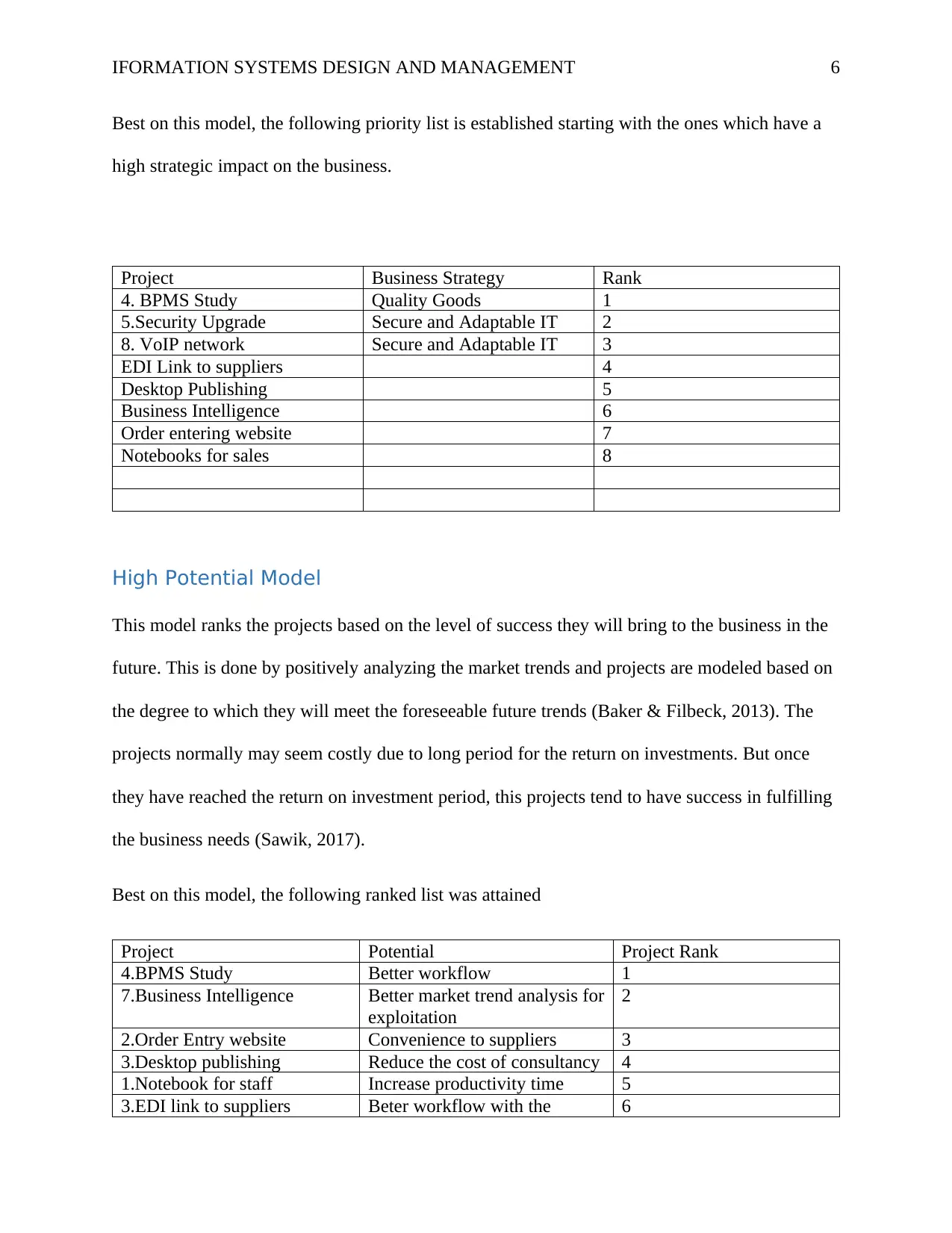
IFORMATION SYSTEMS DESIGN AND MANAGEMENT 6
Best on this model, the following priority list is established starting with the ones which have a
high strategic impact on the business.
Project Business Strategy Rank
4. BPMS Study Quality Goods 1
5.Security Upgrade Secure and Adaptable IT 2
8. VoIP network Secure and Adaptable IT 3
EDI Link to suppliers 4
Desktop Publishing 5
Business Intelligence 6
Order entering website 7
Notebooks for sales 8
High Potential Model
This model ranks the projects based on the level of success they will bring to the business in the
future. This is done by positively analyzing the market trends and projects are modeled based on
the degree to which they will meet the foreseeable future trends (Baker & Filbeck, 2013). The
projects normally may seem costly due to long period for the return on investments. But once
they have reached the return on investment period, this projects tend to have success in fulfilling
the business needs (Sawik, 2017).
Best on this model, the following ranked list was attained
Project Potential Project Rank
4.BPMS Study Better workflow 1
7.Business Intelligence Better market trend analysis for
exploitation
2
2.Order Entry website Convenience to suppliers 3
3.Desktop publishing Reduce the cost of consultancy 4
1.Notebook for staff Increase productivity time 5
3.EDI link to suppliers Beter workflow with the 6
Best on this model, the following priority list is established starting with the ones which have a
high strategic impact on the business.
Project Business Strategy Rank
4. BPMS Study Quality Goods 1
5.Security Upgrade Secure and Adaptable IT 2
8. VoIP network Secure and Adaptable IT 3
EDI Link to suppliers 4
Desktop Publishing 5
Business Intelligence 6
Order entering website 7
Notebooks for sales 8
High Potential Model
This model ranks the projects based on the level of success they will bring to the business in the
future. This is done by positively analyzing the market trends and projects are modeled based on
the degree to which they will meet the foreseeable future trends (Baker & Filbeck, 2013). The
projects normally may seem costly due to long period for the return on investments. But once
they have reached the return on investment period, this projects tend to have success in fulfilling
the business needs (Sawik, 2017).
Best on this model, the following ranked list was attained
Project Potential Project Rank
4.BPMS Study Better workflow 1
7.Business Intelligence Better market trend analysis for
exploitation
2
2.Order Entry website Convenience to suppliers 3
3.Desktop publishing Reduce the cost of consultancy 4
1.Notebook for staff Increase productivity time 5
3.EDI link to suppliers Beter workflow with the 6
⊘ This is a preview!⊘
Do you want full access?
Subscribe today to unlock all pages.

Trusted by 1+ million students worldwide
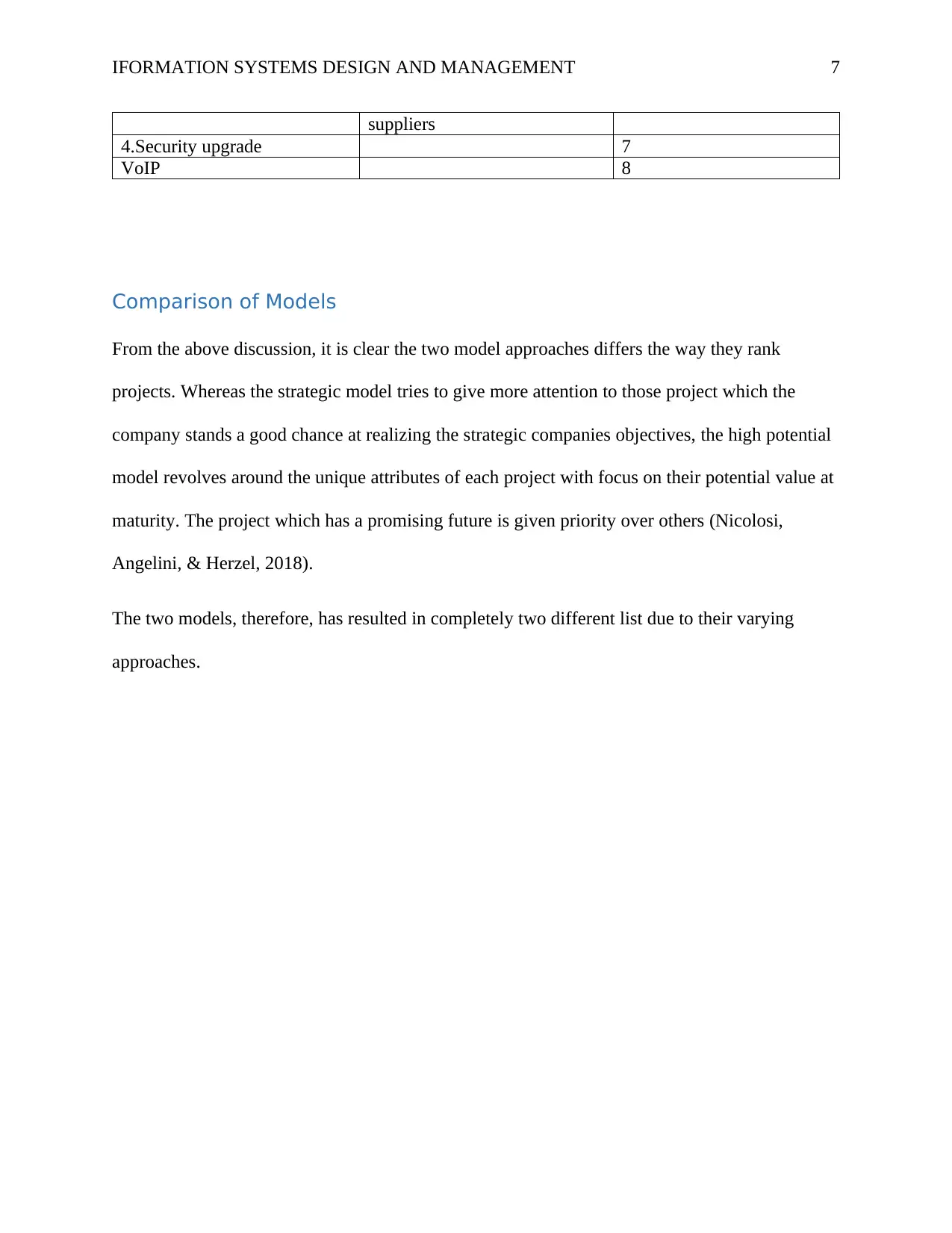
IFORMATION SYSTEMS DESIGN AND MANAGEMENT 7
suppliers
4.Security upgrade 7
VoIP 8
Comparison of Models
From the above discussion, it is clear the two model approaches differs the way they rank
projects. Whereas the strategic model tries to give more attention to those project which the
company stands a good chance at realizing the strategic companies objectives, the high potential
model revolves around the unique attributes of each project with focus on their potential value at
maturity. The project which has a promising future is given priority over others (Nicolosi,
Angelini, & Herzel, 2018).
The two models, therefore, has resulted in completely two different list due to their varying
approaches.
suppliers
4.Security upgrade 7
VoIP 8
Comparison of Models
From the above discussion, it is clear the two model approaches differs the way they rank
projects. Whereas the strategic model tries to give more attention to those project which the
company stands a good chance at realizing the strategic companies objectives, the high potential
model revolves around the unique attributes of each project with focus on their potential value at
maturity. The project which has a promising future is given priority over others (Nicolosi,
Angelini, & Herzel, 2018).
The two models, therefore, has resulted in completely two different list due to their varying
approaches.
Paraphrase This Document
Need a fresh take? Get an instant paraphrase of this document with our AI Paraphraser
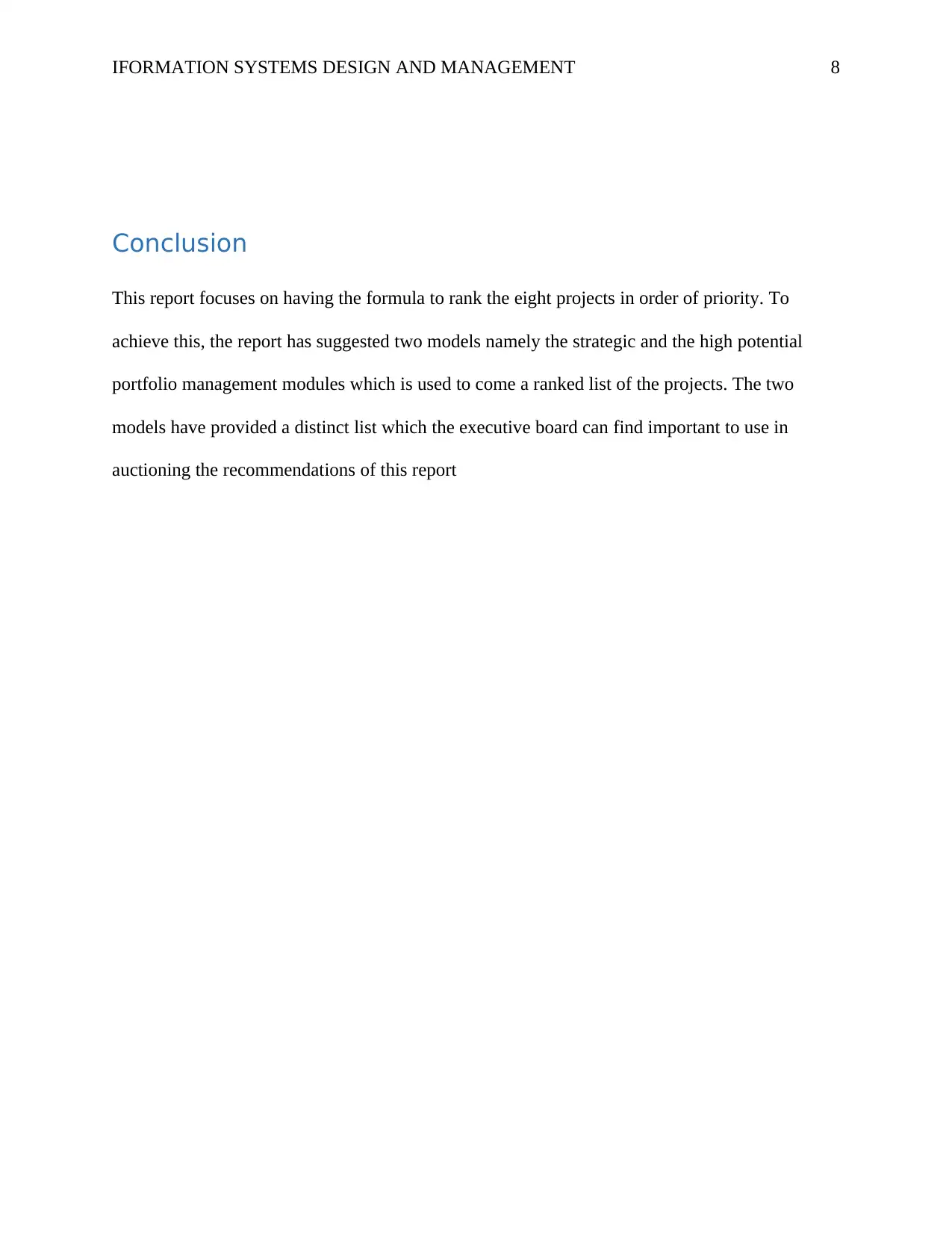
IFORMATION SYSTEMS DESIGN AND MANAGEMENT 8
Conclusion
This report focuses on having the formula to rank the eight projects in order of priority. To
achieve this, the report has suggested two models namely the strategic and the high potential
portfolio management modules which is used to come a ranked list of the projects. The two
models have provided a distinct list which the executive board can find important to use in
auctioning the recommendations of this report
Conclusion
This report focuses on having the formula to rank the eight projects in order of priority. To
achieve this, the report has suggested two models namely the strategic and the high potential
portfolio management modules which is used to come a ranked list of the projects. The two
models have provided a distinct list which the executive board can find important to use in
auctioning the recommendations of this report

IFORMATION SYSTEMS DESIGN AND MANAGEMENT 9
Recommendations
Based on the varying nature of the two lists, the following key recommendation has been put
forward for the executive board
1. Have the strategic list be given priority one to ensure the business vision remains on track
2. Have the high potential projects be executed later to give room for more market research
before resources are commissioned
Recommendations
Based on the varying nature of the two lists, the following key recommendation has been put
forward for the executive board
1. Have the strategic list be given priority one to ensure the business vision remains on track
2. Have the high potential projects be executed later to give room for more market research
before resources are commissioned
⊘ This is a preview!⊘
Do you want full access?
Subscribe today to unlock all pages.

Trusted by 1+ million students worldwide

IFORMATION SYSTEMS DESIGN AND MANAGEMENT 10
References
Alford, R. M., Luchtenberg, K. F., & Reddie, W. D. (2018). Portfolio Management and Earnings
Management: Evidence from Property and Casualty Insurers. Journal of Accounting &
Finance (2158-3625), 18(4), 30–43.
Baker, H. K., & Filbeck, G. (2013). Portfolio Theory and Management. New York: Oxford
University Press.
Nicolosi, M., Angelini, F., & Herzel, S. (2018). Portfolio management with benchmark related
incentives under mean reverting processes. Annals of Operations Research, 266(1/2),
373–394. https://doi.org/10.1007/s10479-017-2535-y
Sawik, T. (2017). A portfolio approach to supply chain disruption management. International
Journal of Production Research, 55(7), 1970–1991.
https://doi.org/10.1080/00207543.2016.1249432
Schrage, B. (2018). Project Portfolio Management Can Ensure Best Use of Time and Resources.
Natural Gas & Electricity, 35(1), 21–25. https://doi.org/10.1002/gas.22069
Sironi, P. (2015). Modern Portfolio Management: From Markowitz to Probabilistic Scenario
Optimisation: Goal-based and Long-term Portfolio Choice. London: Risk Books.
Zhou, J., Mei, L., & Chen, J. (2019). Leveraging University Competitiveness: Evidence from
Alliance Portfolio Practices at Zhejiang University. Emerging Markets Finance & Trade,
55(4), 827–842. https://doi.org/10.1080/1540496X.2018.1504290
References
Alford, R. M., Luchtenberg, K. F., & Reddie, W. D. (2018). Portfolio Management and Earnings
Management: Evidence from Property and Casualty Insurers. Journal of Accounting &
Finance (2158-3625), 18(4), 30–43.
Baker, H. K., & Filbeck, G. (2013). Portfolio Theory and Management. New York: Oxford
University Press.
Nicolosi, M., Angelini, F., & Herzel, S. (2018). Portfolio management with benchmark related
incentives under mean reverting processes. Annals of Operations Research, 266(1/2),
373–394. https://doi.org/10.1007/s10479-017-2535-y
Sawik, T. (2017). A portfolio approach to supply chain disruption management. International
Journal of Production Research, 55(7), 1970–1991.
https://doi.org/10.1080/00207543.2016.1249432
Schrage, B. (2018). Project Portfolio Management Can Ensure Best Use of Time and Resources.
Natural Gas & Electricity, 35(1), 21–25. https://doi.org/10.1002/gas.22069
Sironi, P. (2015). Modern Portfolio Management: From Markowitz to Probabilistic Scenario
Optimisation: Goal-based and Long-term Portfolio Choice. London: Risk Books.
Zhou, J., Mei, L., & Chen, J. (2019). Leveraging University Competitiveness: Evidence from
Alliance Portfolio Practices at Zhejiang University. Emerging Markets Finance & Trade,
55(4), 827–842. https://doi.org/10.1080/1540496X.2018.1504290
1 out of 10
Related Documents
Your All-in-One AI-Powered Toolkit for Academic Success.
+13062052269
info@desklib.com
Available 24*7 on WhatsApp / Email
![[object Object]](/_next/static/media/star-bottom.7253800d.svg)
Unlock your academic potential
Copyright © 2020–2025 A2Z Services. All Rights Reserved. Developed and managed by ZUCOL.





